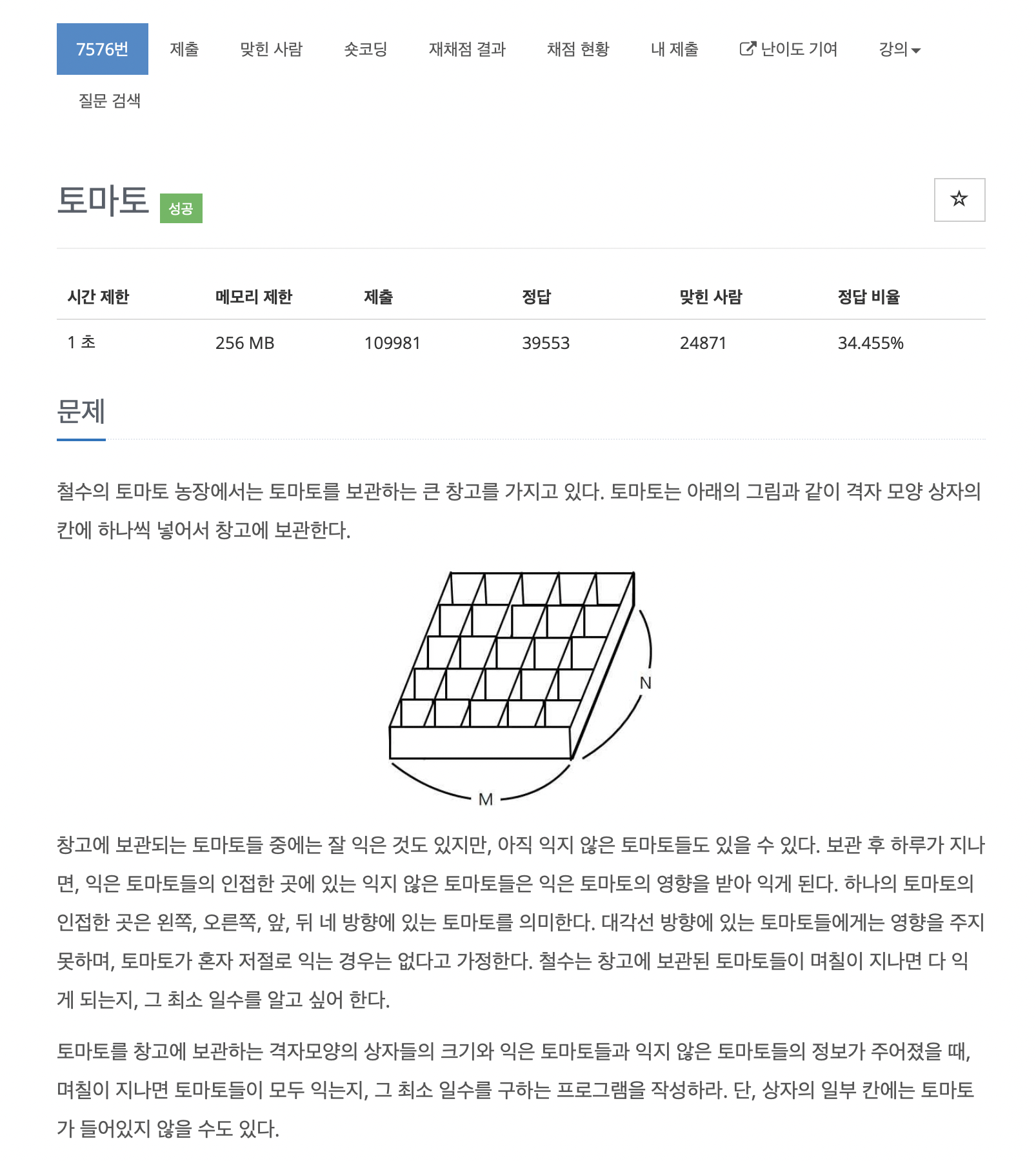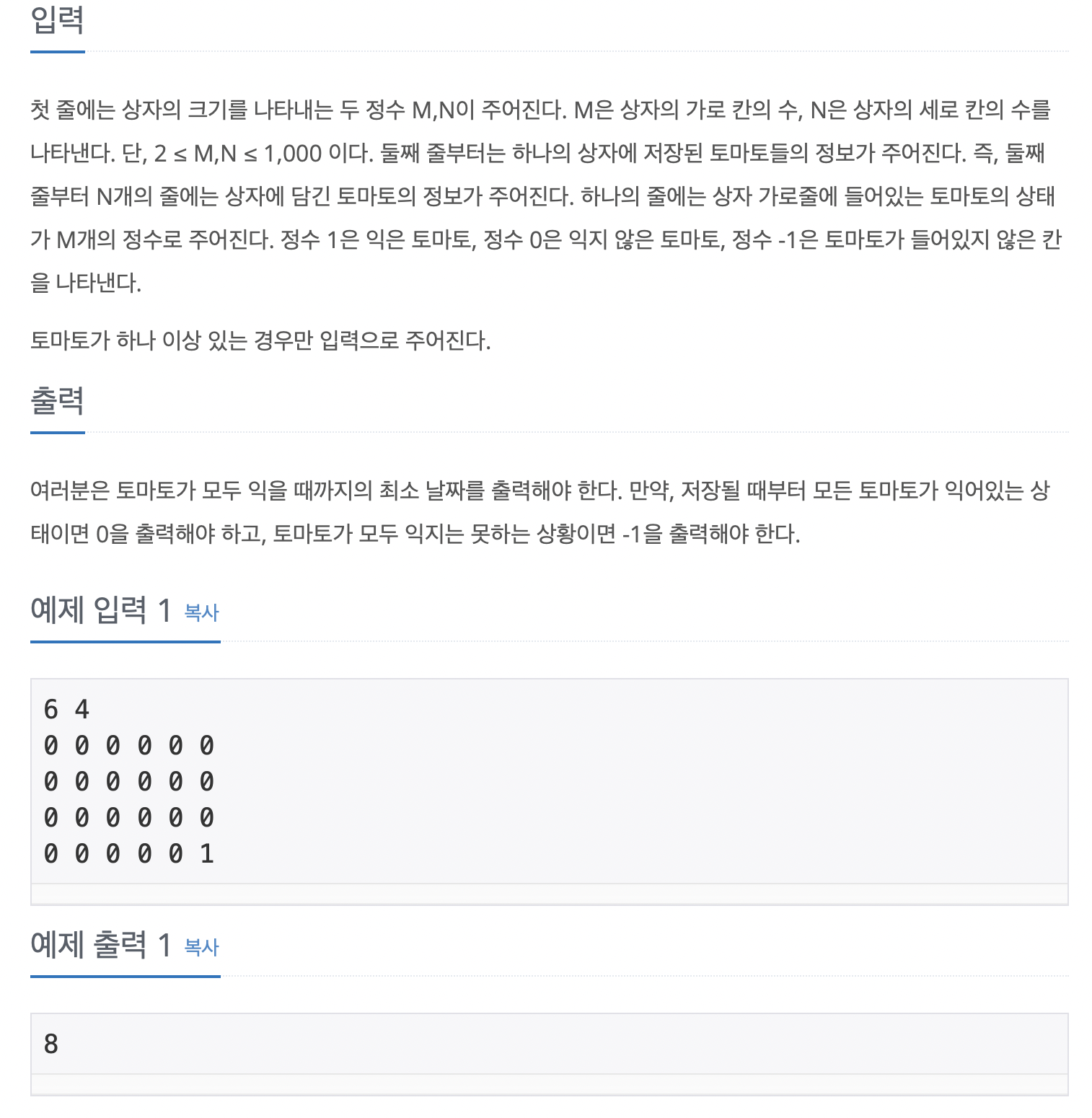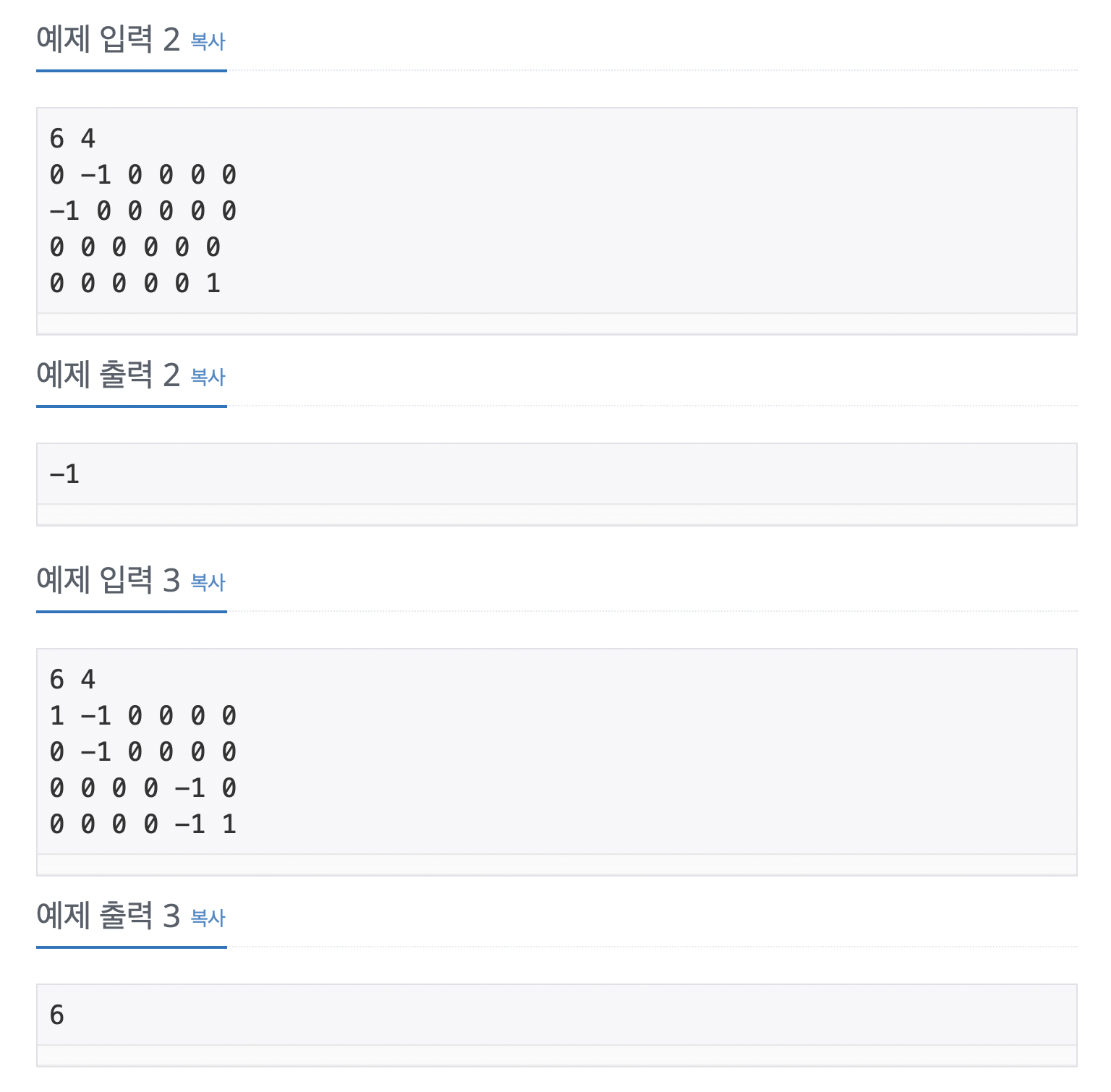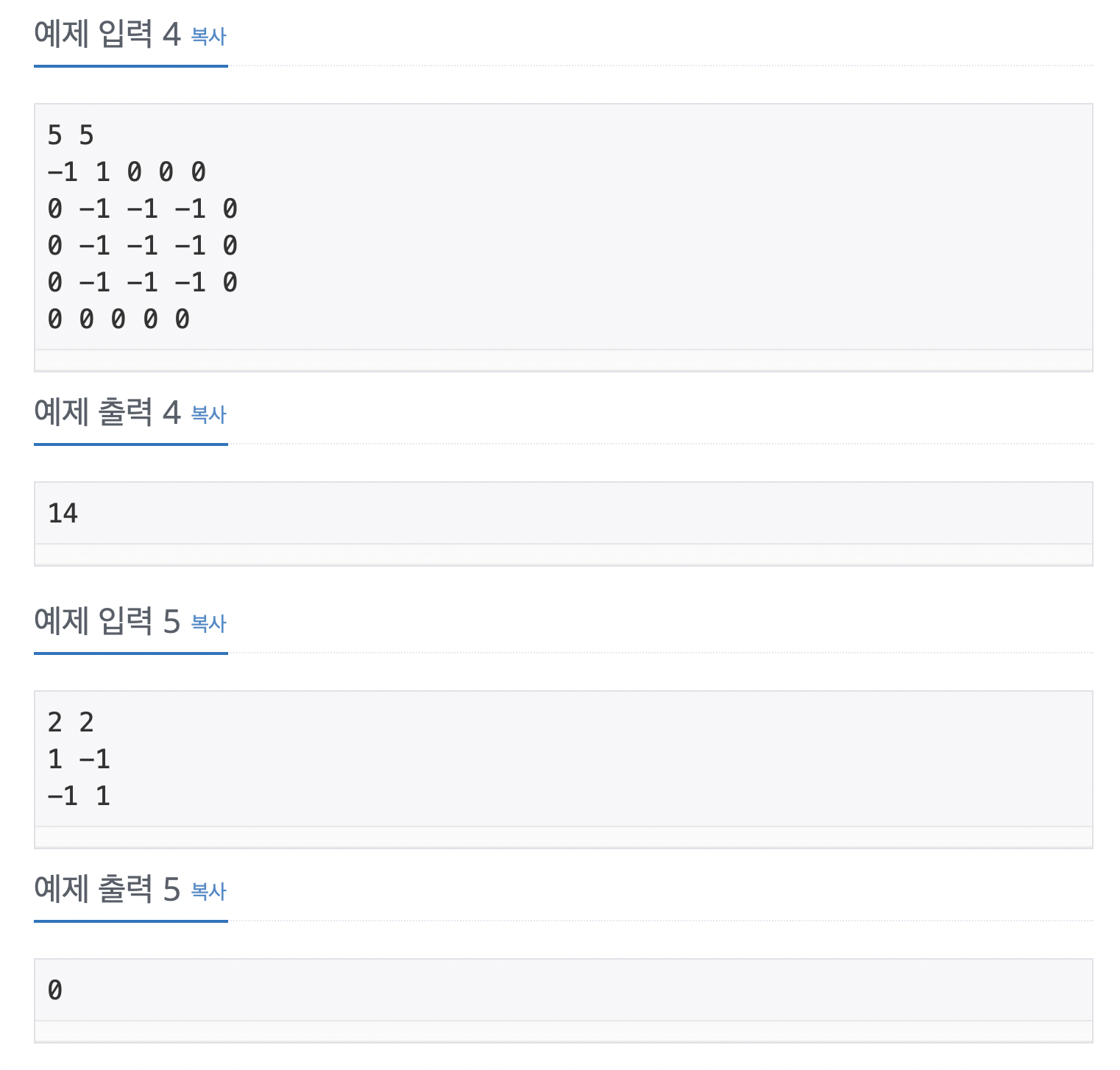
문제는 다음과 같습니다.




미로찾기에서 조금 더 응용된, bfs응용문제입니다.
bfs 시작전에, 토마토가 익어있는 상태인(1인) 모든 지점을 큐에 넣고 시작해야합니다.
(동시에 익어가므로)
그리고 큐에 넣어야 할 정보는 다음과 같습니다.
✅2차원 배열의 인덱스 정보
✅해당 배열에 있는 토마토가 익는 날짜
pair를 중첩해서 이용하였고, 내부의 pair에는 2차원 배열의 인덱스 값을 넣어주었습니다.
➡️pair<pair<int, int>, int>> p;
해당 부분의 코드는 다음과 같습니다.
for(int i=1; i<=m; i++){
for(int j=1; j<=n; j++){
if(a[i][j]==1){
res=0;
ch[i][j]=1;
q.push({{i, j}, res});
}
}
}그리고 bfs가 직접적으로 수행되는 부분은 다음과 같습니다.
토마토가 존재하고, 아직 익지 않았을 때(a[i][j]==0)인 경우에 대해서만,
📌 체크
📌 큐에 push
하면 됩니다.
bfs가 수행되는 부분의 코드는 다음과 같습니다.
// bfs 수행
while(!q.empty()){
pair<pair<int, int>, int> p = q.front(); q.pop();
int i = p.first.first; int j = p.first.second; res=p.second;
if(a[i+1][j]==0 && ch[i+1][j]==0 && i+1<=m){
ch[i+1][j]=1;
q.push({{i+1, j}, res+1});
}
if(a[i-1][j]==0 && ch[i-1][j]==0 && i-1>=1){
ch[i-1][j]=1;
q.push({{i-1, j}, res+1});
}
if(a[i][j+1]==0 && ch[i][j+1]==0 && j+1<=n){
ch[i][j+1]=1;
q.push({{i, j+1}, res+1});
}
if(a[i][j-1]==0 && ch[i][j-1]==0 && j-1>=1){
ch[i][j-1]=1;
q.push({{i, j-1}, res+1});
}
} // bfs 끝전체 코드는 다음과 같습니다.
#include <bits/stdc++.h>
using namespace std;
int main() {
ios_base::sync_with_stdio(false);
cin.tie(nullptr);
int a[1002][1002]={0, };
int ch[1002][1002]={0, };
queue<pair<pair<int, int>, int>> q;
int n, m, res;
cin>>n>>m;
for(int i=1; i<=m; i++){
for(int j=1; j<=n; j++){
int tmp; cin>>tmp;
a[i][j]=tmp;
}
} // 배열 입력 완료
for(int i=1; i<=m; i++){
for(int j=1; j<=n; j++){
if(a[i][j]==1){
res=0;
ch[i][j]=1;
q.push({{i, j}, res});
}
}
}
// bfs 수행
while(!q.empty()){
pair<pair<int, int>, int> p = q.front(); q.pop();
int i = p.first.first; int j = p.first.second; res=p.second;
if(a[i+1][j]==0 && ch[i+1][j]==0 && i+1<=m){
ch[i+1][j]=1;
q.push({{i+1, j}, res+1});
}
if(a[i-1][j]==0 && ch[i-1][j]==0 && i-1>=1){
ch[i-1][j]=1;
q.push({{i-1, j}, res+1});
}
if(a[i][j+1]==0 && ch[i][j+1]==0 && j+1<=n){
ch[i][j+1]=1;
q.push({{i, j+1}, res+1});
}
if(a[i][j-1]==0 && ch[i][j-1]==0 && j-1>=1){
ch[i][j-1]=1;
q.push({{i, j-1}, res+1});
}
} // bfs 끝
for(int i=1; i<=m; i++){
for(int j=1; j<=n; j++){
if(a[i][j]==0 && ch[i][j]==0){
cout<<"-1\n";
return 0;
}
}
}
cout<<res<<endl;
return 0;
}그리고 마지막 부분에서,
❗️토마토가 모두 익지 못하는 예외가 발생할 수 있으므로,
이에대한 예외처리를 해야 합니다.
전체 배열을 돌면서, 해당 배열에 토마토가 존재하지만 ch가 되어있지 않으면
해당 토마토는 익지못한 것이므로, 여기부분에서 예외처리를 수행하면 됩니다.
2/19 토요일 복습)
#include <bits/stdc++.h>
using namespace std;
int main() {
ios_base::sync_with_stdio(false);
cin.tie(nullptr);
int a[1002][1002]={0, }; int ch[1002][1002]={0, };
queue<pair<pair<int, int>, int>> q; int n, m, day;
cin>>m>>n;
for(int i=1; i<=n; i++){
for(int j=1; j<=m; j++){
cin>>a[i][j];
if(a[i][j]==1) { ch[i][j]=1; q.push({{i, j}, 0}); }
}
}
while(!q.empty()){
pair<pair<int, int>, int> p = q.front(); q.pop();
int t1 = p.first.first; int t2 = p.first.second; day = p.second;
if(t1+1<=n && a[t1+1][t2]==0 && ch[t1+1][t2]==0){
ch[t1+1][t2]=1; q.push({{t1+1, t2}, day+1});
}
if(t2+1<=m && a[t1][t2+1]==0 && ch[t1][t2+1]==0){
ch[t1][t2+1]=1; q.push({{t1, t2+1}, day+1});
}
if(t1-1>=1 && a[t1-1][t2]==0 && ch[t1-1][t2]==0){
ch[t1-1][t2]=1; q.push({{t1-1, t2}, day+1});
}
if(t2-1>=1 && a[t1][t2-1]==0 && ch[t1][t2-1]==0){
ch[t1][t2-1]=1; q.push({{t1, t2-1}, day+1});
}
}
for(int i=1; i<=n; i++){
for(int j=1; j<=m; j++){
if(ch[i][j]==0 && a[i][j]==0) { cout<<"-1"; return 0; }
}
}
cout<<day;
return 0;
}